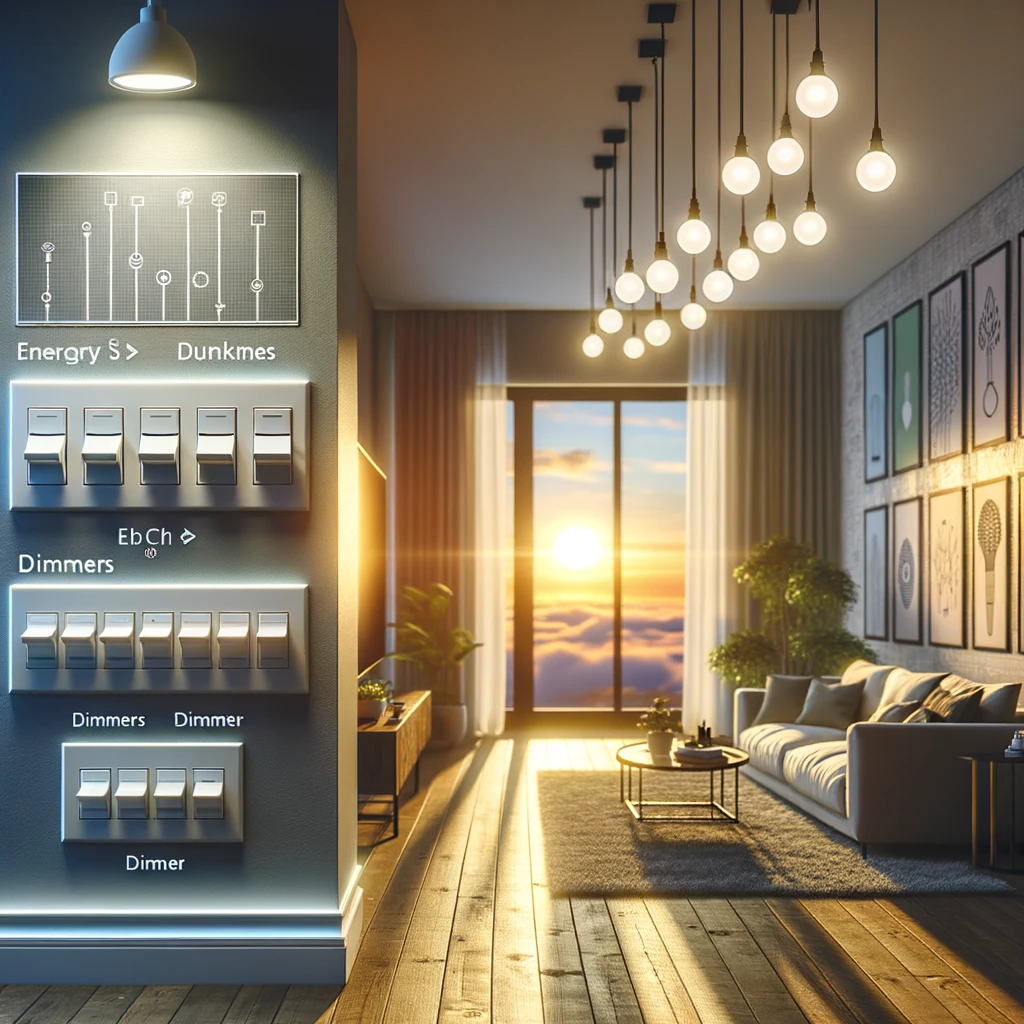Introduction

The Power of Illumination
Dimmers play a crucial role in lighting control, allowing individuals to adjust the intensity of light in a space. Defined as devices that regulate the voltage supplied to lamps, dimmers offer a versatile solution for creating desired ambiance and enhancing energy efficiency.
Redefining Lighting Control

Lighting control is an essential aspect of interior design, as it significantly impacts the overall atmosphere and functionality of a space. By utilizing dimmers, individuals can go beyond simple on/off switches and have precise control over the brightness levels in their environment. This level of control allows for customized experiences tailored to specific needs or preferences.
Achieving Ambiance
Dimmers provide the ability to set the perfect mood by adjusting light levels according to different occasions or activities. Whether one desires soft, romantic lighting for a cozy dinner or bright, vibrant illumination for productive work sessions, dimmers allow effortless customization. This flexibility empowers individuals to transform their spaces into dynamic environments that suit their needs at any given moment.
Energy Efficiency through Light Control
In addition to enhancing ambiance, dimmers also contribute to energy efficiency by reducing electricity consumption. By dimming lights when full brightness is unnecessary, significant energy savings can be achieved over time. For instance, lowering light levels by just 10% can result in an average energy reduction of 10%, resulting in lower utility bills and reduced carbon footprint.
The Synergy of Dimming Systems
Furthermore, integrating dimmers with smart home systems enables advanced lighting automation and scheduling features. With these capabilities, users can easily create lighting profiles that align with their daily routines or optimize energy usage based on occupancy patterns within a space.
As technology continues to evolve, dimming systems are becoming increasingly intelligent and interconnected within larger ecosystems. Overall, understanding dimmers and their role in lighting control is essential for those seeking to create dynamic atmospheres, reduce energy consumption, and embrace the cutting-edge possibilities of home automation.
The Basics of Dimmers
How dimmers work: voltage regulation and waveform modification
Dimmers regulate the voltage supplied to lighting fixtures, allowing users to control the brightness levels. They achieve this by modifying the electrical waveform that powers the bulbs.
Voltage regulation involves reducing or increasing the voltage, which directly affects the intensity of light emitted by lamps. By adjusting the voltage, dimmers can create varying levels of illumination, from bright to dim.
Types of dimmers: leading-edge vs trailing-edge dimmers
There are two main types of dimmers commonly used: leading-edge and trailing-edge. Leading-edge dimmers work well with incandescent and halogen lamps. They control brightness by cutting off a portion of each half-cycle in the AC power supply waveform.
These dimmers are cost-effective and widely available. On the other hand, trailing-edge dimmers are designed for use with LED and CFL lamps as they provide smoother and more precise control over these energy-efficient lighting sources.
Trailing-edge dimming involves gradually reducing or delaying the end of each half-cycle in the AC power supply waveform, resulting in a softer light output. These types of dimmers are typically more expensive due to their advanced technology but offer compatibility with a wider range of modern lighting options.
Both leading-edge and trailing-edge dimmers play an essential role in controlling lighting levels based on specific requirements. Leading-edge is suitable for traditional incandescent and halogen lamps, while trailing-edge is compatible with LED and CFL lights that demand smoother adjustments to achieve optimal illumination.
Benefits of Dimming Systems
Energy savings:
Dimming reduces power consumption and extends lamp life. By lowering the light output, dimmers decrease the amount of energy consumed by lighting fixtures.
This not only results in cost savings but also contributes to environmental sustainability by reducing overall energy usage. Additionally, dimming can significantly extend the lifespan of lamps since they are subjected to lower levels of stress when operated at reduced light levels.
Integration with smart home systems enables scheduling and automation. Dimmers can be connected to smart home platforms, allowing for advanced control options.
With scheduling capabilities, users can program lights to automatically adjust based on time of day or occupancy patterns, optimizing energy usage even further. Automation features enable lights to be triggered by specific events or sensors, enhancing convenience and customization possibilities.
Flexibility in lighting design:
Adjusting light levels to create desired moods or highlight specific areas. Dimmers provide the ability to tailor lighting according to individual preferences and specific needs of different spaces within a room.
Whether it’s creating a cozy atmosphere for a romantic dinner or brightening up an area for task-oriented activities, dimming allows users to effortlessly set the perfect ambiance. Enhancing visual comfort by reducing glare.
Brightness control plays a crucial role in minimizing glare from excessive lighting levels, which can cause discomfort and eye strain. By dimming lights appropriately, glare is reduced and visual comfort is improved, promoting a more pleasant environment for occupants.
Dimmers offer numerous benefits in terms of energy savings and flexibility in design when it comes to lighting control systems. They contribute towards reducing power consumption while extending lamp life through optimized brightness levels.
Additionally, integrating dimmers with smart home systems enables scheduling and automation capabilities that enhance convenience and customization options for users’ lighting needs. Moreover, the ability to adjust light levels allows for creating desired moods and highlighting specific areas, while reducing glare enhances visual comfort.
Different Types of Dimming Control Methods
Manual dimming controls:
Rotary or slide switches provide a traditional wall-mounted control option for adjusting the brightness of lights. Remote controls offer the convenience of handheld devices for easily and wirelessly adjusting light levels.
Digital control systems:
Phase-control dimming systems employ phase-cutting techniques to achieve smooth dimming functionality. a) Triac-based systems are suitable for resistive loads such as incandescent lamps, allowing precise control over their brightness. b) MOSFET-based systems are compatible with electronic transformers and low-voltage halogen lamps, providing efficient dimming without flickering or buzzing noises.
Digital Addressable Lighting Interface (DALI):
DALI is an advanced digital protocol that allows individual control of each luminaire in a networked lighting system. a) DALI enables precise brightness adjustment, creating dynamic lighting scenes tailored to specific needs or preferences.
b) Additionally, DALI facilitates advanced features like daylight harvesting, which automatically adjusts light levels based on available natural light, and occupancy sensing that detects human presence to activate or deactivate lights accordingly. These different types of dimming control methods offer flexibility and customization options when it comes to adjusting lighting levels in various environments, contributing to enhanced comfort, energy efficiency, and overall ambiance.
Dimming Challenges and Solutions
Compatibility issues:
Compatibility issues arise when attempting to dim certain types of lamps or integrating dimmers with existing lighting systems. LED lamps, for example, may exhibit flickering or buzzing when used with incompatible dimmers. One solution is to choose dimmable LED lamps specifically designed to work with leading-edge or trailing-edge dimmers.
Additionally, some dimmers have adjustable settings to accommodate different lamp types, allowing for better compatibility. Another solution is the use of electronic transformers or low-voltage halogen lamps that are compatible with MOSFET-based dimming systems.
Conclusion

Dimmers play a crucial role in lighting control by providing energy efficiency, flexibility in design, and improved visual comfort. They allow for the adjustment of light levels to create desired moods and enhance ambiance.
While compatibility issues may pose challenges in the implementation of dimmers, there are solutions available such as choosing compatible lamp types and adjusting the settings on the dimmer itself. By overcoming these challenges and embracing the benefits of lighting control through the use of dimmers, we can create more efficient and enjoyable lighting environments that suit our unique needs and preferences.
Remember that proper planning and research are essential when selecting and installing dimming systems to ensure compatibility with specific lamp types and existing infrastructure. With the right approach, we can harness the power of dimmers to transform our spaces into beautifully lit environments while saving energy and improving overall functionality.









